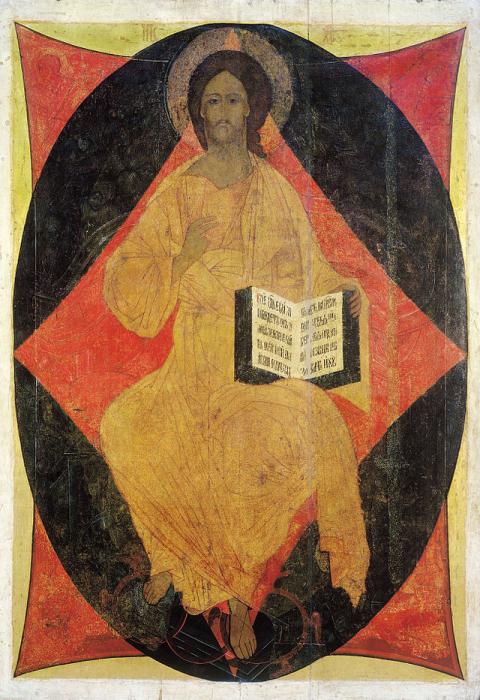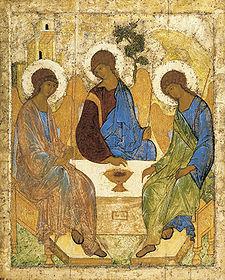In Russia and abroad its name is well known - Andrei Rublev. Icons and murals created by the master about six centuries ago are a real gem of Russian art and still concern people’s aesthetic feelings.
First information
Where and when Andrei Rublev was born is unknown. There are suggestions that this happened around 1360-70, in the Principality of Moscow, or in Veliky Novgorod. Information about when the master began to paint the faces of the Saints is contained in medieval historical documents. From the “Trinity Chronicle”, found in Moscow, it is known that, being a Chernets (monk), Rublev painted together Feofan Grek and Prokhor Gorodetsky the house church of Prince Vladimir Dmitrievich, son of Dmitry Donskoy.
Iconostasis of Vladimir Cathedral
A few years later, according to the same Trinity Chronicle, in collaboration with the famous icon painter Daniil Cherny, it was Andrei Rublev who restored the Vladimir Uspensky Cathedral after the Mongol invasion. The icons that made up a single ensemble with frescoes survived to the present day. True, in the magnificent era of Catherine the Second, the dilapidated iconostasis turned out to be inconsistent with the current fashion, and it was transferred from the cathedral to the village of Vasilyevskoye (now - the Ivanovo region). In the 20th century, these icons were restored, some of them were included in the collection of the State Russian Museum in St. Petersburg, another part was placed in the State Tretyakov Gallery in Moscow.
Deesis
The central part of the Vladimir iconostasis, which consists of icons painted by Andrei Rublev, is occupied by Deesis (“prayer” translated from Greek). His main idea is God's judgment, which in the Orthodox community is called the Terrible. More precisely, this is the idea of the ardent intercession of the saints before Christ for the entire human race. The image is imbued with the high spirit of love and mercy, nobleness and moral beauty. In the center on the throne is Jesus with the open gospel in his hands. The figure is inscribed in a scarlet rhombus, this color symbolizes regality and at the same time sacrifice. The rhombus is placed in a green-blue oval, personifying the union of the human with the Divine. This composition is in the red square, each corner of which recalls the four Evangelists - Matthew, Mark, Luke and John. Soft shades are harmoniously combined with harmonious clarity of lines.
Features in the image of the faces of the Saints
What new things did Andrei Rublev bring to the image of the Savior? Icons depicting the Lord existed in Byzantine culture, however, the amazing combination of majestic solemnity with extraordinary meekness and tenderness makes the master’s creations unsurpassed and unique. In the image of Rublevsky Christ, the views of Russian people on justice are clearly visible. With a fiery hope of judgment - just and right - the faces of saints praying before Jesus are full. The appearance of the Virgin is filled with supplications and sorrows, and in the image of the Forerunner an inexplicable grief is read for the entire lost human race. Apostles John Chrysostom and Gregory the Great, Andrew the First-Called and John the Evangelist selflessly pray to the Savior . As the worshiping angels, the archangels Gabriel and Michael are depicted here, their images are full of heavenly solemn beauty, talking about the wonderful world of heaven.
"Spas" by Andrei Rublev
Among the iconographic images of the master, there are several masterpieces, which are said to be the icon of the Savior.
Andrei Rublev was preoccupied with the image of Jesus Christ, and indeed, by the hand of the great painter, such works as “The Almighty Savior”, “The Savior the Miraculous”, “The Savior of the Golden Hair”, and the “Savior in power” were created. Emphasizing the extraordinary spiritual gentleness of the Lord, Rublev guessed the main component of the Russian national ideal. It is no coincidence that the color scheme is shining with a gentle warm light. This went against the Byzantine tradition, in which the face of the Savior was painted with contrasting strokes, contrasting the green and brown colors of the background with the highly luminous lines of facial features.

If we compare the face of Christ created by the Byzantine master Theophanes the Greek, who, according to some accounts, was Rublev’s teacher, with the images painted by the student, we will see a clear difference in manner. Rublev puts paints smoothly, preferring the contrast of soft transitions of light into shadow. The lower layers of paint transparently shine through the upper, as if from within the icon a quiet joyful light streams. That is why its iconography with confidence can be called luminiferous.
"Trinity"
Or as they call it, the icon of the Holy Trinity by Andrei Rublev is one of the greatest creations of the Russian Renaissance. It is based on the most famous biblical story about how the righteous Abraham was visited by the Triune God in the guise of three angels.
The creation of the “Trinity” icon by Andrei Rublev dates back to the history of painting the Trinity Cathedral. It was placed to the right of the Royal Gates in the lower, as expected, row of the iconostasis.
The mystery of the Holy Trinity
The composition of the icon is built so that the figures of the angels form a symbolic circle - a sign of eternity. They sit around a table with a bowl in which lies the head of the sacrificial calf - a symbol of redemption. The central and left angels bless the cup.
Behind the angels, we see Abraham's house, the oak tree under which he received his Guests, and the peak of Mount Moriah, on which Abraham ascended to sacrifice the son of Isaac. There, later, in the time of Solomon, the first temple was erected.
It is traditionally believed that the figure of the middle angel depicts Jesus Christ, his right hand with folded fingers symbolizes unconditional obedience to the will of the Father. The angel on the left is the figure of the Father blessing the cup that the Son will have to drink to atone for the sins of all mankind. The right angel depicts the Holy Spirit overshadowing the consent of the Father and the Son and comforting Him who will soon sacrifice himself. So Andrei Rublev saw the Holy Trinity. His icons are generally always full of high symbolic sound, but in this it is especially penetrating.

There are, however, researchers who interpret the compositional distribution of the faces of the Holy Trinity in a different way. They say that God the Father sits in the middle, behind whose back the Tree of Life is depicted - a symbol of source and completion. We read about this tree on the first pages of the Bible (it grows in the Garden of Eden) and on its last pages when we see it in New Jerusalem. The Left Angel is located on the background of the structure, which can mean the Housebuilding of Christ - His Ecumenical Church. We see the right Angels against the backdrop of the mountain: it was on the mountain that the Holy Spirit descended upon the apostles after the Ascension of Christ.
The color plays a special role in the space of the icon. Noble gold shines in it, delicate ocher, greenery, azure blue and soft pink shimmer. The sliding color transitions are in harmony with the smooth tilts of the head, the movements of the hands of calmly sitting Angels. In the faces of the three hypostases of the Godhead lies an unearthly sadness and at the same time peace.
Finally
The icons of Andrei Rublev are mysterious and ambiguous. Photos that contain images of the Divine give us an incomprehensible feeling of confidence that the meaning of the Universe and every human life is in loving and reliable hands.